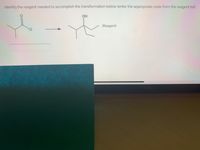
Organic Chemistry
9th Edition
ISBN: 9781305080485
Author: John E. McMurry
Publisher: Cengage Learning
expand_more
expand_more
format_list_bulleted
Question
hw help 12

Transcribed Image Text:Identify the reagent needed to accomplish the transformation below (enter the appropriate code from the reagent list)
OH
IReagent
![Alkyl Halides (X = CI, Br or I): Assume AICI, is present if needed
2 of 2
G
un acid catalyst [H+], or pyridine, is present if needed.
он
OH
OH
CHJOH
AA
BB
DD
EE
FF
GG
HH
Ketones, Aldehydes and Epoxides: Assume "then H,0" is included if a protonation step is needed
K.
P
R
V
Acid Chlorides: Assume AICI, or pyridine is present if needed
YY
zZ
Other Reagents:
11 PCC in CH2C2
21 Br2, FeBr3
22 Mg. Et,0
23 Cl2, AICI3
24 SOCI2, pyridine
25 HNO3, H2SO4
26 fuming H2SO4
1 H3O* (dilute H2SO4) or H3O*, heat
2 conc. H2SO4, heat
3 NaOEt
12 NazCr207, H2S04, H2O
13 BH3•THF or 9-BBN, then H2O2, NaOH
14 Hg(OAc)2, H2O, then NaBH4
15 O3, then Zn, HCI or DMS
16 MCPBA or CH;CO3H
17 Br2, light or NBS, heat
4 t-BUOK
5 H2, Pt
6 H2, Lindlar's catalyst
7 Na, NH3
8 LAH or xs LAH, then H20
9 NABH4, CH3OH
10 NABH,CN, pH 5
27 Fe, HCI; then NaOH
28 Zn(Hg). НCI
29 KCN, or KCN + HCN
30 CO2, then H30*
18 HBr
19 HBr, ROOR
20 PB13
31 (H*]. HOʻ
32 NH3 (1 or 2 equiv.)
33 CH,NH2 (1 or 2 equiv)
34 (CH3)½NH (1 or 2 equiv)
35 EINH2 (1 or 2 equiv)
36 PHCH,NH2 (1 or 2 equiv).
37 LDA, -78 °C
(-H20)
Grignard, Wittig and Gilman Reagents:
Assume "then H,0" is included if a protonation step is needed
MgBr
MeMgBr
EtMgBr
PhMgBr
G1
G2
G3
G4
CuLi
Me,Culi Et,Culi (PHCH2),CULI
38 NaH, 25 °C
39 LIAI(OR);H, then H20
40 DIBAH, then H2O
41 Br2. [H3O*]
42 Br2, NaOH
43 Pyridine
G5
G6
G7
G8
MePh,P=CH2 PhyP=CHCH3 PhyP=CHCO,Et PhyP=CHPH
W1
w2
W3
W4](https://content.bartleby.com/qna-images/question/bc96294a-6867-4c53-8945-7b1c26d22cf9/d5c62ddf-d1ee-4dbe-91f7-c85e62936578/ylaw1i9_thumbnail.jpeg)
Transcribed Image Text:Alkyl Halides (X = CI, Br or I): Assume AICI, is present if needed
2 of 2
G
un acid catalyst [H+], or pyridine, is present if needed.
он
OH
OH
CHJOH
AA
BB
DD
EE
FF
GG
HH
Ketones, Aldehydes and Epoxides: Assume "then H,0" is included if a protonation step is needed
K.
P
R
V
Acid Chlorides: Assume AICI, or pyridine is present if needed
YY
zZ
Other Reagents:
11 PCC in CH2C2
21 Br2, FeBr3
22 Mg. Et,0
23 Cl2, AICI3
24 SOCI2, pyridine
25 HNO3, H2SO4
26 fuming H2SO4
1 H3O* (dilute H2SO4) or H3O*, heat
2 conc. H2SO4, heat
3 NaOEt
12 NazCr207, H2S04, H2O
13 BH3•THF or 9-BBN, then H2O2, NaOH
14 Hg(OAc)2, H2O, then NaBH4
15 O3, then Zn, HCI or DMS
16 MCPBA or CH;CO3H
17 Br2, light or NBS, heat
4 t-BUOK
5 H2, Pt
6 H2, Lindlar's catalyst
7 Na, NH3
8 LAH or xs LAH, then H20
9 NABH4, CH3OH
10 NABH,CN, pH 5
27 Fe, HCI; then NaOH
28 Zn(Hg). НCI
29 KCN, or KCN + HCN
30 CO2, then H30*
18 HBr
19 HBr, ROOR
20 PB13
31 (H*]. HOʻ
32 NH3 (1 or 2 equiv.)
33 CH,NH2 (1 or 2 equiv)
34 (CH3)½NH (1 or 2 equiv)
35 EINH2 (1 or 2 equiv)
36 PHCH,NH2 (1 or 2 equiv).
37 LDA, -78 °C
(-H20)
Grignard, Wittig and Gilman Reagents:
Assume "then H,0" is included if a protonation step is needed
MgBr
MeMgBr
EtMgBr
PhMgBr
G1
G2
G3
G4
CuLi
Me,Culi Et,Culi (PHCH2),CULI
38 NaH, 25 °C
39 LIAI(OR);H, then H20
40 DIBAH, then H2O
41 Br2. [H3O*]
42 Br2, NaOH
43 Pyridine
G5
G6
G7
G8
MePh,P=CH2 PhyP=CHCH3 PhyP=CHCO,Et PhyP=CHPH
W1
w2
W3
W4
Expert Solution
This question has been solved!
Explore an expertly crafted, step-by-step solution for a thorough understanding of key concepts.
This is a popular solution
Trending nowThis is a popular solution!
Step by stepSolved in 2 steps with 1 images

Knowledge Booster
Learn more about
Need a deep-dive on the concept behind this application? Look no further. Learn more about this topic, chemistry and related others by exploring similar questions and additional content below.Similar questions
- Draw in the reagents for the following reactions and products. Ox dantarrow_forwardProvide reagents needed for the following transformations. More than one step is required for each reaction. 1 2 3 Br Provide missing reagents Provide missing reagents Provide missing reagents tu OH OHarrow_forwardplz do with mechanismarrow_forward
arrow_back_ios
SEE MORE QUESTIONS
arrow_forward_ios
Recommended textbooks for you

 Organic ChemistryChemistryISBN:9781305580350Author:William H. Brown, Brent L. Iverson, Eric Anslyn, Christopher S. FootePublisher:Cengage Learning
Organic ChemistryChemistryISBN:9781305580350Author:William H. Brown, Brent L. Iverson, Eric Anslyn, Christopher S. FootePublisher:Cengage Learning


Organic Chemistry
Chemistry
ISBN:9781305580350
Author:William H. Brown, Brent L. Iverson, Eric Anslyn, Christopher S. Foote
Publisher:Cengage Learning